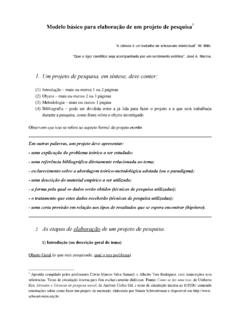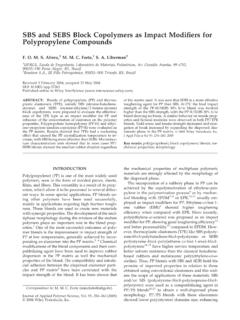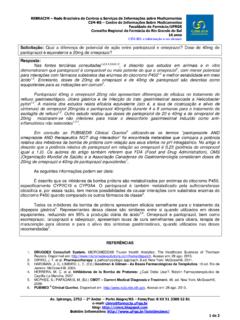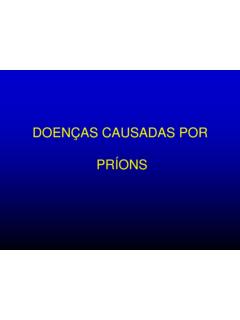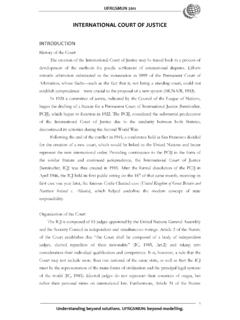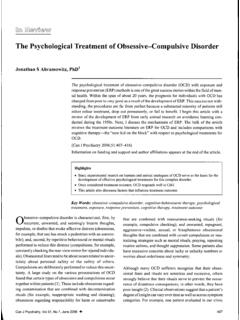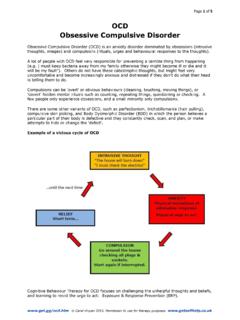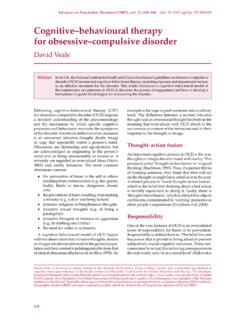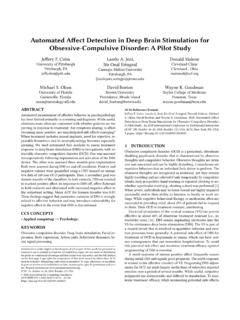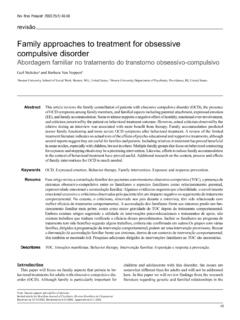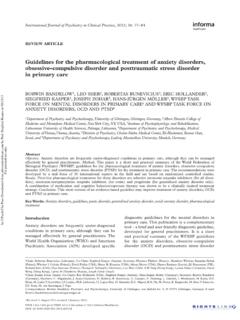Transcription of Psychological treatment of obsessive–compulsive disorder
1 obsessive compulsive disOrderpsYcHiATrY 6:6229 2007 published by elsevier treatment of obsessive compulsive disorderpaul m s alkovskisAbstractNice guidelines recommend Psychological treatment (cognitive behavioural therapy, involving major elements of exposure and response prevention) as the first-line treatment for obsessive compulsive disorder (Ocd ). in this contribution, the theory and practice of integrated cognitive behavioural therapy is described. The use of normalizing strategies and re-appraisal of beliefs motivating compulsive behaviour are emphasized as ways of enabling patients to choose to change. developments in terms of dissemi-nation and delivery are cognitive behaviour therapy; cognitive models; dissemination of Psychological treatments; obsessive compulsive disorder ; Ocd ; treat-ment integrity The Psychological treatment of obsessive compulsive disorder (OCD) is highly effective only when it takes the form of beha viour therapy or cognitive behavioural therapy (CBT).
2 Such treatment is closely linked to learning and cognitive behavioural theories of the maintenance of OCD. The first published descrip tion of CBT came in 1966 from Meyer, in case series described as the modification of expectations in cases with obsessional ritu als .1 This work led to the treatment now known as exposure and response prevention,2 and ultimately to cognitive behavioural behavioural understanding of obsessionsSalkovskis described a cognitive behavioural approach to the understanding and treatment of obsessional problems,3 building on behavioural theories and 8 In this approach, obses sions are conceptualized as normal intrusive thoughts, which the sufferer misinterprets as a sign that harm to themselves or to others is a serious risk and that they are responsible for such harm (or its prevention). This interpretation has several effects, such as: increased discomfort, including (but not confined to) anxiety and depression the focusing of attention both on the intrusions themselves and triggers in the environment that may increase their occurrencePaul M Salkovskis MPhil FBPsS is Professor of Clinical Psychology and Applied Science at the Institute of Psychiatry, London, UK, and Clinical Director of the Centre for Anxiety disorders and Trauma, London.
3 His research interests include anxiety disorders , health psychology and communication/ethics. Conflicts of interest: none declared. increased accessibility to and preoccupation with the original thought and other related ideas behavioural responses, including neutralizing reactions in which the person seeks to reduce or escape responsibility (such behaviours can be overt or covert).The inflated sense of responsibility that the sufferer attaches to his or her activities leads them into a pattern of mental and behavioural effort characterized by both over control and pre occupation. (Figure 1 shows this cognitive behavioural model of the development and maintenance of obsessional problems.) Efforts at over control increase distress for a number of reasons. Direct and deliberate attention to mental activity can modify the contents of consciousness.
4 Efforts to deliberately control a range of mental activities appar ently and actually result in failure and even in opposite effects. Attempts to prevent harm and responsibility for harm increase the salience and accessibility of the patients concerns with harm, neutralizing efforts directed at preventing model of OCDE arly experiences(making youvulnerable to OCD)Critical incidents(what startedthe OCD off)Assumptions, general beliefs( not preventing disaster is as bad asmaking it happen; better safe than sorry)Misinterpretations of significance ofintrusions responsibility for actionsIntrusive thoughts, images, urges, doubtsNeutralizing actions (rituals, reassurance,mental argument)Attention andreasoning biases(looking for trouble)Counterproductivesafety strategies(through suppression,impossible criteria,avoidance)Mood changes(distress, anxiety,depression)ActivatesFigure 1 obsessive compulsive disOrderpsYcHiATrY 6:6230 2007 published by elsevier beliefsTreatment requires modification of the beliefs involved in and leading to the misinterpretation of intrusive thoughts as indi cating heightened responsibility, and of the associated behavi ours involved in the maintenance of these beliefs.
5 Obsessional patients are distressed because they have a particularly threaten ing perception of their obsessional experience; for example, that their thoughts mean that they are a child molester, or that they are in constant danger of passing disease on to other people. The essence of treatment is helping the sufferer to construct and test a new, less threatening model of their elements of treatmentThe treatment protocol specifies a number of stages of treatment , allowing flexibility of application. Working with patients to develop a comprehensive cognitive behavioural model of the maintenance of their obsessional prob lems as an alternative to the fears that they have. Detailed identification and self monitoring of obsessional thoughts, and patients appraisal of them, combined with strat egies designed to help modify their beliefs about responsibility. Discussion techniques and behavioural experiments intended to challenge negative appraisals and the basic assumptions on which these are based.
6 The aim is modification of the patient s negative beliefs about the extent of their own personal re sponsibility ( by asking the patient to describe all contributing factors for a feared outcome and then dividing the contributions in a pie chart). Behavioural experiments to directly test appraisals, assump tions and processes hypothesized to be involved in the patient s obsessional problems ( demonstrating that attempts to sup press a thought lead to an increase in the frequency with which it occurs, or showing that beliefs such as if I think it, I must want it to happen are incorrect). Each behavioural experiment is idiosyncratically devised in order to help the patient test their previous (threatening) explanation of their experience against the new (non threatening) explanation worked out with their therapist. Helping patients to identify and modify underlying general assumptions (such as not trying to prevent harm is as bad as making it happen deliberately ) which give rise to their mis interpretation of their own mental and response prevention strategies (see below) are used to help the patient discover the way in which neutralizing behaviour acts to maintain their beliefs and the associated discomfort, and discover that stopping such behaviours is questioning and discussion about a particular episode is used to identify the particular intrusion (thought, image, impulse or doubt) and the significance that the person attached to it ( the way the intrusion was interpreted/appraised).
7 The therapist then helps the patient focus on the way their particular inter pretation, at the time in question, resulted in both distress and the desire (compulsion) to prevent or put right any possible harm that the patient has foreseen. Thus, discussion helps the patient and therapist identify the specific sequence as shown in Figure the way intrusions are interpreted by normalizing themGiven that the focus of treatment is on helping the patient to adopt and test an alternative, less threatening explanation of their problems, most therapy techniques focus on reappraisal. A key component of this is normalizing the experience of intrusions, helping the patient to change their understanding of the signifi cance of the occurrence and content of intrusions. Guided discov ery is used to help patients consider several important questions: who has obsessional thoughts?
8 How common are intrusive thoughts? do they occur only in people suffering from OCD? why are intrusions so common? are they of any use?Understanding and testing counterproductive strategiesHaving worked on de catastrophizing the occurrence and content of intrusions, the therapist then helps the patient understand and deal with responses that are involved in the maintenance of their negative beliefs. This is done through interwoven discussion and behavioural experiments designed to help the patient gather further evidence for the way in which the mechanisms identified affect them and the effects of stopping their counterproductive behaviours. For example, the patient may be asked to consider what usually happens to some one who tries to avoid thinking about something that is important to them. Have they themselves ever had the experience of trying not to think of something?
9 Could they try now, in the office, not to think of giraffes? What happens? Why would trying not to think of some thing make this thing come to mind more, both now and later?Assessing the significance of an intrusionIntrusionInterpretation Reactions tothe interpretationEffects of these reactions bothon the interpretation and on the occurrence of intrusionsFigure 2 obsessive compulsive disOrderpsYcHiATrY 6:6231 2007 published by elsevier up homework experiments involving an alternating treatments experimental design can be helpful in gathering further evidence for the importance of the paradoxical effects of thought suppression. The patient keeps a daily diary of intrusive thoughts, and also records the amount of effort they put into suppression in the course of the day. They are then asked to try very hard to get rid of their intrusions by suppressing them on some days ( Monday, Wednesday, Friday and Sunday), and to simply record the occur rence of thoughts, without making any special attempts at suppres sion, on the other days.
10 The frequency of intrusions is plotted on a graph, with the two types of days interspersed. Figure 3 shows an example from an actual patient. This patient recorded their intru sions in a diary for a week, then alternated suppression/recording for a further week. Ratings of suppression were also recorded, and indicated that the patient had indeed suppressed more on the days when instructed to do this. The thought frequency information was then plotted. The patient was shown their graph, and asked what they made of the results as a step towards helping them to stop any efforts to resist, suppress or neutralize their and behavioural experimentsEarly in the course of CBT, the notion of exposure and response prevention (ERP) is introduced and a more planned and detailed programme Such a programme is discussed with the patient as the logical extension of the previous strategies for belief change, with an appropriate combination of explicit aims, as follows.
